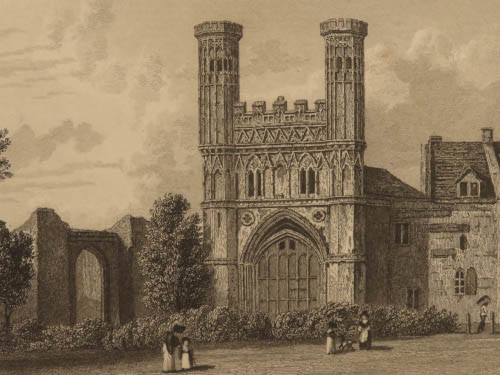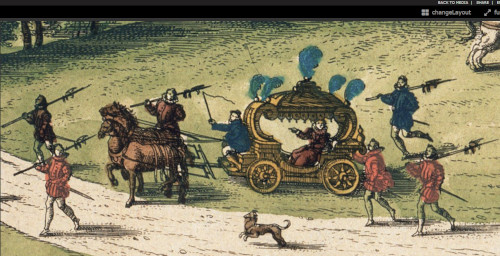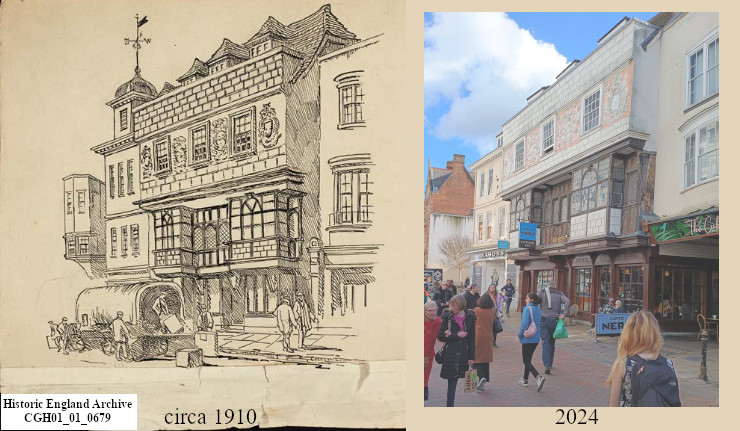 |
| Conservation | City
Views |
Space
Between |
| New Buildings | Shop Fronts | Advertising |
|
CONSERVATION Landmark buildings in Canterbury, whether of domestic scale or large civic statements, combine unique historic cultural functions with particular construction technologies rooted in the materiality and practices of the time. They are resonant of their time and are literally irreplaceable, while generally continuing in daily use, and forming part of the familiar fabric of the city. |
|
One of the most exuberant and
well-preserved commercial buildings in Canterbury, 44-45
High Street is a 16th century three storey jettied building
with the current facade added in the 17th century and the
dormer windows in the 18th century. The plastered panels on
the second floor date from 1663. This building was probably
originally constructed as a pilgrim's lodging house, and
remained in use as an inn until the late 18th century.
Theatre performances are known to have taken place in the Yard behind the Inn, by then called the Crown, in the 1720's. The building has passed through a range of commercial activities since then and is currently a café where refreshment can be enjoyed upstairs in the still impressive first floor chamber. This room is now known as "Queen Elizabeth's Guest Chamber", following the legend that Queen Elizabeth I stayed there during her 15 days, 40th birthday visit to Canterbury in September 1573. However there is ample contemporaneous evidence that she and much of her Council and Court actually stayed elsewhere.  Fyndon's
Gate
Grade I Listed 1830 engraving William Westall In 1538 the Commissioners of
Henry VIII had seized St. Austin's (now known as St.
Augustine's Abbey) which had occasionally been used as a
convenient place for Henry and other royal travellers to
reside as guests of the abbot, whilst they were passing
through Canterbury. The very large house of the abbot now
became the main part of a new royal palace, approached
through the still impressive Fyndon's Gate. The refurbished
palace included adjacent ancilliary buildings and when
completed was leased in 1564 to Lord Cobham.
At this period the palace was surrounded by a substantial courtyard wall and this situation offered a far better protected and more comfortable residence for a Queen than a High Street inn! However, as the royal entourage on a typical Elizabethan progress was around 2000 strong, plus horses, there is little doubt that most of the inns in Canterbury and their stables, including the Crown, would have been requisitioned as overflow accommodation. The Archbishop of Canterbury's palace, next to the Cathedral, and other large houses around Canterbury would also have been filled with guests. Evidence for the Queen's
actual lodging place on that occasion is further contained
in a letter from her host in Canterbury, Archbishop Matthew
Parker, two years later to the Archbishop of York, Edmund
Grindal:
"And I left her at Dover, and came home to Bekesborne that night: and after that, went to Canterbury to receive her Majesty there which I did, with the Bishops of Lincoln and Rochester, and my Suffragan, at the West door; where, after the Grammarian had made his Oration to her upon her horseback, she alighted. We then kneeled down, and said the Psalm Deus misereatur in English, with certain other Collects briefly; and that in our chimers and rochets. The Quire, with the Dean and Prebendaries, stood on either side of the Church, and brought her Majesty up with a Square-song, she going under a canopy, born by four of her Temporal Knights, to her traverse placed by the Communion board; where she heard Even-song, and after departed to her lodging at St. Austin's, whither I waited upon her. From thence I brought certain of the Council, and divers of the Court, to my house to supper, and gave them fourteen or fifteen dishes, furnished with two mess at my long table, whereat sat about twenty." The progresses and public
processions of Queen Elizabeth.
Volume 1 1823 John Nichols. Page 345  The Queen's progress to her Nonsuch Palace Detail from an engraving, based on a 1582 drawing by Hoefnagel. As a final note it is worth
mentioning that as early as 1381 the first Crown Inn in
Canterbury was situated adjacent to, and north, of the
Cheker Inn in Mercery Lane. This is recorded in a
lease, CCA-DCc/ChAnt/C/1228A, held in the Canterbury
Cathedral Archives which states that a tenement called "la
Crowne" was conveyed to John Roper of Westgate on 24th
June 1381. In 1400 Roper sold the lease on to
Prior Chillenden of Christ Church Priory, Canterbury and
it is thought that it eventually became absorbed in a
re-devrlopment of the Cheker Inn. Perhaps it was at this
time that the name "Crown Inn" was transferred to the
building in the High Street discussed above.
|
